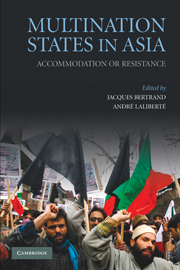Book contents
- Frontmatter
- Contents
- List of Tables and Figures
- List of Maps
- List of Contributors
- Acknowledgments
- Maps
- 1 Introduction
- 2 Revolutionary State Formation and the Unitary Republic of Indonesia
- 3 The Crisis of Border States in India
- 4 Pakistan: Neither State Nor Nation
- 5 Constitutional Politics and Crisis in Sri Lanka
- 6 The Dilemmas of Burma's Multinational Society
- 7 The Double-Edged Sword of Autonomy in Indonesia and the Philippines
- 8 China and the Virtual Taiwan Nation
- 9 The Failure of Ideologies in China's Relations with Tibetans
- 10 Leninism's Long Shadow in Central Asia
- 11 Conclusion
- References
- Index
6 - The Dilemmas of Burma's Multinational Society
Published online by Cambridge University Press: 05 June 2012
- Frontmatter
- Contents
- List of Tables and Figures
- List of Maps
- List of Contributors
- Acknowledgments
- Maps
- 1 Introduction
- 2 Revolutionary State Formation and the Unitary Republic of Indonesia
- 3 The Crisis of Border States in India
- 4 Pakistan: Neither State Nor Nation
- 5 Constitutional Politics and Crisis in Sri Lanka
- 6 The Dilemmas of Burma's Multinational Society
- 7 The Double-Edged Sword of Autonomy in Indonesia and the Philippines
- 8 China and the Virtual Taiwan Nation
- 9 The Failure of Ideologies in China's Relations with Tibetans
- 10 Leninism's Long Shadow in Central Asia
- 11 Conclusion
- References
- Index
Summary
Since Burma won its independence in 1948, successive Burmese governments have confronted claims of multiple sub-state nationalist groups to the right of greater autonomy and separate independent states. The common position taken by all Burmese central governments is that appeasing such demands could create a domino effect leading to the breakup of the country, and thus it is believed that these movements must be contained as much as possible. Concern over losing political power and control of economic resources is another reason why the Burmese governments have been reluctant to devolve power to the sub-national levels.
This chapter assesses policies and practices implemented by successive governments toward sub-state nationalist groups in post-colonial Burma. It stresses, in particular, the Shan, Kachin, Karen, Kayah, Mon, Arakan, and Chin – the seven largest sub-state nationalist groups, whose names correspond to the current seven states in Burma. The first part of the chapter sets out historical paths that laid the foundation for Burma's multiple nations and analyzes the emergence of sub-state nationalist movements. The period after independence saw the central authorities attempting to appease secessionist demands by forming three ethnically based states and by giving them considerable civil and political freedom and the right to express ethnic identity. However, a lack of consensus within the ruling coalition (the majority of whom later took up arms against the state), failure to implement greater autonomy at the regional levels, and weak state infrastructure handicapped the government's ability to handle competing claims made by sub-state nationalist groups.
- Type
- Chapter
- Information
- Multination States in AsiaAccommodation or Resistance, pp. 136 - 163Publisher: Cambridge University PressPrint publication year: 2010



